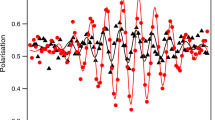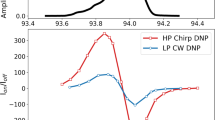Abstract
THE nuclear magnetic resonance spectrum of a solid rotated at high speed consists of a narrowed central line and a set of side-spectra spaced at integral multiples of the rotation rate of either side1,2. The interaction energy between each pair on nuclear magnets in the solid contains the angular factor (3 cos2θ – 1), where θ is the angle between the internuclear vector and the applied field. When the solid rotates about an axis making an angle α with the applied field, the angular factor may be expressed3 as the sum of its mean value ½ (3 cos2 α – 1) (3 cos2 γ – 1), where γ is the angle between the internuclear vector and the axis of rotation, and two time-dependent terms, (3/2) sin 2α sin 2γ cos ωr t, and (3/2) sin2 α sin2 γ cos 2 ωr t, where ωr is the angular frequency of rotation. The two time-dependent terms lead to the formation of the side-spectra. It should be noted that when α is 90°, as in our earlier experiments1,2, the first of these terms is absent, so that side-spectra occur in this case at even multiples of ωr only ; for general α, the side-spectra occur at odd and even multiples of ωr. The form of the mean value of the angular factor for each nuclear pair leads to the conclusion that the central spectrum should have the shape found for the static crystal when the applied field is directed along the axis of rotation, but reduced in width by the factor ½ (3 cos2 α – 1), and having a second moment4 reduced by a factor ¼ (3 cos2 α – 1)2. Thus, in particular, when α has the value cos−1 (1/√3) = 54° 44′, the dipolar broadening of the central line should be removed5. With a speed of rotation large compared with the static line-width, the side-spectra will be displaced far from the centre and will be weak, leaving only a sharp central line broadened by residual non-dipolar causes.
This is a preview of subscription content, access via your institution
Access options
Subscribe to this journal
Receive 51 print issues and online access
$199.00 per year
only $3.90 per issue
Buy this article
- Purchase on Springer Link
- Instant access to full article PDF
Prices may be subject to local taxes which are calculated during checkout
Similar content being viewed by others
References
Andrew, E. R., Bradbury, A., and Eades, R. G., Colloque Ampère, Paris, July 11, 1958; Arch. Sci., 11, 223 (1958).
Andrew, E. R., Bradbury, A., and Eades, R. G., Nature, 182, 1659 (1958).
Andrew, E. R., and Newing, R. A., Proc. Phys. Soc., 72, 959 (1958).
Van Vleck, J. H., Phys. Rev., 74, 1168 (1948).
Andrew, E. R., Colloque Ampère, London, April 2, 1959.
Author information
Authors and Affiliations
Rights and permissions
About this article
Cite this article
ANDREW, E., BRADBURY, A. & EADES, R. Removal of Dipolar Broadening of Nuclear Magnetic Resonance Spectra of Solids by Specimen Rotation. Nature 183, 1802–1803 (1959). https://doi.org/10.1038/1831802a0
Issue Date:
DOI: https://doi.org/10.1038/1831802a0
This article is cited by
-
NMR spectroscopy for metabolomics in the living system: recent progress and future challenges
Analytical and Bioanalytical Chemistry (2024)
-
Solid–Liquid Phase Transitions of Triglycerides in Griebenschmalz, Smalec, and Fedt Studied Using 13C Solid-State NMR with Dynamics-Based Spectral Filtering
Applied Magnetic Resonance (2023)
-
In vitro proton magnetic resonance spectroscopy at 14T for benign and malignant ovary: Part II, Signal processing by the parametric fast Padé transform
Journal of Mathematical Chemistry (2022)
-
Multidimensional diffusion MRI with spectrally modulated gradients reveals unprecedented microstructural detail
Scientific Reports (2019)
-
Orientationally-averaged diffusion-attenuated magnetic resonance signal for locally-anisotropic diffusion
Scientific Reports (2019)
Comments
By submitting a comment you agree to abide by our Terms and Community Guidelines. If you find something abusive or that does not comply with our terms or guidelines please flag it as inappropriate.



